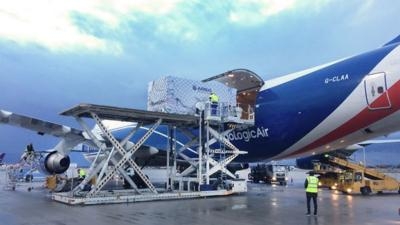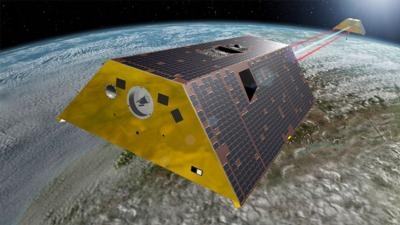Sat, Dec 16, 2017
German-Built Gravity Research Spacecraft Are On The Way To Vandenberg Air Force Base In California
The twin GRACE-FO satellites have begun their journey to Vandenberg Air Force Base in California. Together with test equipment totalling around 50 tons, the gravity research satellites built and developed by Airbus in Friedrichshafen (Germany) were loaded overnight onto an air freighter at Munich airport and flown to the U.S. Tuesday. GRACE-FO is a joint project between NASA’s Jet Propulsion Laboratory (JPL) based in Pasadena, California, and the German Research Center for Geosciences (GFZ) in Potsdam.

Both GRACE-FO research satellites are scheduled for launch in spring 2018, and will be placed in a polar orbit of around 310 miles and with a distance of 136 miles between them. The mission is planned to last at least five years. The satellites will constantly measure the distance between each other to within a few microns using a microwave system built at JPL. At the same time, a sensitive accelerometer, built at Onera in France, will account for non-gravitational effects, such as atmospheric drag and solar radiation.

The data will be used to track the movement of liquid water, ice and land masses by creating monthly maps of the changes in Earth’s gravitational field. GRACE-FO continues this essential climate record established by the predecessor GRACE mission, a joint project between the United States and Germany. GRACE ended its science operations in October after more than 15 years of operations.
The GRACE-FO satellites will also feature a new inter-satellite laser ranging instrument, developed in a German/American joint venture, which will be tested for use in future generations of satellites. In addition, each satellite will record up to 200 profiles per day of temperature distribution and water-vapour content in the atmosphere and the ionosphere to aid weather forecasting.
A team of 15 Airbus space engineers and technicians are currently awaiting the arrival of the satellites in California. The plan is to assemble all test systems on site and check the GRACE-FO spacecraft before the Christmas break in readiness for the launch campaign in 2018.
(Images provided with Airbus news release)
More News
Its Offerings Are Lighter, Cleaner, and Now Pushing Past 1,000nm on SAF Jet Fuel DeltaHawk’s diesel-powered aircraft lineup has seen incredible upgrades over the last few yea>[...]
The Airplane Experienced A Total Loss Of Engine Power On December 3, 2025, about 1600 central standard time, a Mooney Aircraft Corp. M20K, N57229, was substantially damaged when it>[...]
Make Sure You NEVER Miss A New Story From Aero-News Network Do you ever feel like you never see posts from a certain person or page on Facebook or Instagram? Here’s how you c>[...]
Aero Linx: European Society of Aerospace Medicine (ESAM) As a pan-European, independent forum, it works to promote the safety and health of all persons involved in aviation and spa>[...]
“We are excited to see Wisk achieve this milestone, and I’m so proud of the team that made it possible. The team at Wisk has built advanced technologies across flight c>[...]
 Aero-TV: DeltaHawks Diesel Power Steps Into the Spotlight
Aero-TV: DeltaHawks Diesel Power Steps Into the Spotlight NTSB Prelim: Mooney Aircraft Corp. M20K
NTSB Prelim: Mooney Aircraft Corp. M20K ANN FAQ: Turn On Post Notifications
ANN FAQ: Turn On Post Notifications ANN's Daily Aero-Linx (12.20.25)
ANN's Daily Aero-Linx (12.20.25) Aero-News: Quote of the Day (12.20.25)
Aero-News: Quote of the Day (12.20.25)




